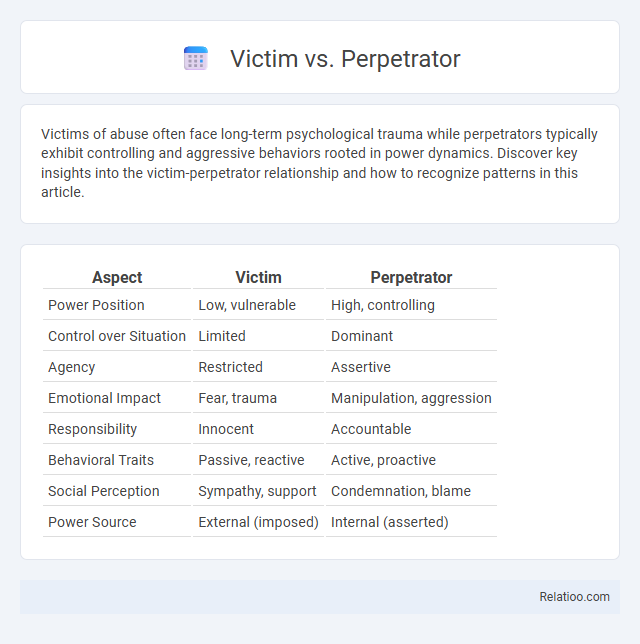Victims of abuse often face long-term psychological trauma while perpetrators typically exhibit controlling and aggressive behaviors rooted in power dynamics. Discover key insights into the victim-perpetrator relationship and how to recognize patterns in this article.
Table of Comparison
| Aspect | Victim | Perpetrator |
|---|---|---|
| Power Position | Low, vulnerable | High, controlling |
| Control over Situation | Limited | Dominant |
| Agency | Restricted | Assertive |
| Emotional Impact | Fear, trauma | Manipulation, aggression |
| Responsibility | Innocent | Accountable |
| Behavioral Traits | Passive, reactive | Active, proactive |
| Social Perception | Sympathy, support | Condemnation, blame |
| Power Source | External (imposed) | Internal (asserted) |
Understanding the Roles: Victim vs Perpetrator
Understanding the roles of victim and perpetrator is crucial in analyzing conflict dynamics and legal responsibility. Victims experience harm or injustice, often requiring support and protection, while perpetrators commit actions causing such harm, facing accountability. Your awareness of these distinct roles enhances empathy and informed decision-making in social and judicial contexts.
Key Differences in Behavior and Motivation
Victim behavior often involves vulnerability, fear, and a need for support due to harm experienced, while perpetrators exhibit control, aggression, and intent to cause harm or dominate. Victimization is the process or state of being harmed or exploited, highlighting the impact on the victim rather than the actions of the perpetrator. Your understanding of these distinctions clarifies the roles individuals play in harmful interactions, aiding in more effective responses and interventions.
Psychological Impact on Victims
Victimization often leads to profound psychological impacts, including trauma, anxiety, and a diminished sense of safety that can persist long after the event. Understanding the distinct roles of victim and perpetrator helps contextualize the emotional and cognitive effects experienced by individuals subjected to harm. Your recovery process depends on recognizing these impacts and seeking appropriate mental health support to rebuild resilience.
The Mindset of a Perpetrator
The mindset of a perpetrator often involves a desire for control, power, or revenge, fueled by underlying psychological factors such as anger, entitlement, or a distorted moral compass. Understanding this mindset helps in identifying patterns of behavior that contribute to victimization, allowing you to better recognize warning signs and protect yourself. Profiling perpetrators provides insight into their motivations and methods, which is essential for preventing harm and supporting victims effectively.
Societal Perceptions and Misconceptions
Societal perceptions often simplify the complex dynamics between victim, perpetrator, and victimization, leading to misconceptions that influence justice outcomes and public empathy. Victims are frequently stigmatized or doubted, while perpetrators may be excused due to bias or misinformation, distorting accountability measures. Your understanding of these roles helps challenge stereotypes and promotes a more accurate, compassionate view of crime and its impact on individuals and communities.
Legal Definitions and Implications
Victim refers to an individual who suffers harm or loss due to a criminal act, while perpetrator denotes the person who commits the offense. Victimization encompasses the process and impact of being subjected to harmful acts, including physical, emotional, or financial damage. Legal implications involve the rights of victims to seek justice and restitution, and the prosecution of perpetrators under criminal law to ensure accountability and deterrence.
Identifying Signs of Victimization
Identifying signs of victimization involves recognizing physical injuries, behavioral changes such as withdrawal or anxiety, and inconsistent explanations for harm or distress. Victims often exhibit emotional symptoms including fear, depression, or hypervigilance, while perpetrators may display controlling or aggressive behaviors aimed at maintaining power over the victim. Effective assessment requires a thorough understanding of these indicators within the context of the victim-perpetrator relationship to provide appropriate support and intervention.
Factors That Influence Perpetrator Behavior
Perpetrator behavior is influenced by a complex interplay of psychological, social, and environmental factors, including exposure to violence, mental health issues, and socioeconomic stressors. Genetic predispositions and neurobiological abnormalities can also contribute to aggressive tendencies and delinquent behavior. Understanding these influences is crucial for developing targeted interventions to prevent victimization and reduce recidivism rates.
Support Systems for Victims
Support systems for victims play a crucial role in addressing the complex dynamics between victims, perpetrators, and victimization by providing emotional counseling, legal assistance, and safety planning to help survivors regain control and rebuild their lives. Specialized organizations and community programs focus on trauma-informed care and advocacy, ensuring victims receive tailored support that acknowledges the impact of perpetrator actions and the cycle of victimization. Access to comprehensive resources, including crisis hotlines and shelters, enhances victim empowerment and promotes healing while holding perpetrators accountable in the justice system.
Strategies for Prevention and Intervention
Effective prevention and intervention strategies for victimization include implementing educational programs that raise awareness about risk factors and promote bystander intervention. Law enforcement agencies employ evidence-based approaches such as trauma-informed care and offender rehabilitation to address perpetrator behavior and reduce recidivism. Community collaboration enhances support systems by integrating victim services, counseling, and legal assistance to empower victims and disrupt cycles of abuse.

Infographic: Victim vs Perpetrator
 relatioo.com
relatioo.com